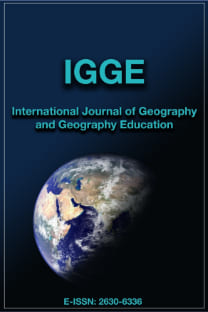OVERVIEW OF DOMESTIC WATER SUPPLY IN KANO STATE, NIGERIA
Accessibility to safe and clean domestic water by households is paramount for personal and developmental health at all levels in Nigeria. Kano State Water Board (KSWB) was saddle with responsibility of domestic water supply to the entire state. The state have about 22 water treatment plants that source, treat and distribute water to the residents of the study area. The data collected were from secondary sources, descriptive statistics was the statistical instruments used in the data analysis. KSWB supply about 415 million litres daily (MLD) to the Kano city and its environs and about 92 MLD to local government headquarters and semi-urban areas. Similarly, there about 50 commercial water standing pumps being operated and maintained by KSWB to ease water supply to nook and crannies of the state.Where pipe borne water is not connected, boreholes, hands pumped and concrete wells are constructed by Rural Water Supply and Sanitation Agency (RUWASA) to ease water supply at sufficient quality and quantity to rural communities in the state.
Anahtar Kelimeler:
Kano state, Domestic Water Supply, Nigeria
OVERVIEW OF DOMESTIC WATER SUPPLY IN KANO STATE, NIGERIA
Accessibility to safe and clean domestic water by households is paramount for personal and developmental health at all levels in Nigeria. Kano State Water Board (KSWB) was saddle with responsibility of domestic water supply to the entire state. The state have about 22 water treatment plants that source, treat and distribute water to the residents of the study area. The data collected were from secondary sources, descriptive statistics was the statistical instruments used in the data analysis. KSWB supply about 415 million litres daily (MLD) to the Kano city and its environs and about 92 MLD to local government headquarters and semi-urban areas. Similarly, there about 50 commercial water standing pumps being operated and maintained by KSWB to ease water supply to nook and crannies of the state.Where pipe borne water is not connected, boreholes, hands pumped and concrete wells are constructed by Rural Water Supply and Sanitation Agency (RUWASA) to ease water supply at sufficient quality and quantity to rural communities in the state.
Keywords:
Domestic Water Supply, Kano State, Nigeria,
___
- Abdulkadir, B., Nura, I. B., Tajudden I. W. & Ibrahim K. A. (2019). Assessment of water supply shortages in Zango, Rimin Kebe area, Ungogo Local Government, Kano State.DUJOPAS5 (2a), 23-30.
- Ajadi, B. S. (2010). Portable water availability and consumption pattern in Ilorin metropolis, Nigeria. Global Journal of Human Social Science,10 (6/1), 44-50.
- Bello, N. I & Abdullahi, I. K. (2014). Water supply situations in Kano metropolitan prospects and challenges. International Journal of Research in Earth & Environmental Sciences, 1(4),25-32
- Bello, N. I., Shehu, A., Abubakar, S.A., Bello, A. & Imam, M. Z. (2021). Water vendors participation in domestic water supply in Unguwa Uku, Tarauni Local Government, Kano State, Nigeria. Fudma Journal of Science, 4(4), 252-258. DOI: https//doi.org/10.33003/fjs-2020-0404-509
- Bello, N.I. & Tuna, F. (2014). Evaluation of potable water demand and supply in Kano State, Nigeria. International Journal of Scientific Knowledge, Computing and Information Technology, 4(6), 35-46.
- Berta, M. (2015). State Water Agencies in Nigeria A Performance Assessment. World Bank Group
- Kano State Government, Kano State Water Board Customer Service Charter, 2014
- Mohammed, A. H & Sanaullah, P. (2017). An empirical analysis of domestic water sources, consumption and associated factors in Kandahar city, Afghanistan. Resources and Environment Journal, 17(2), 49-61.
- National population commission (2006). Gender and sustainable development, Nigeria population census 1991, analysis.
- Nura, I. B., Abdulkadir, B., Ahmad, S. A. & Ibrahim, K. A. (2020). Water consumption determinants in Rimin Kebe area, Ungogo Local Government, Kano State, Nigeria. International Journal of Research and Innovation in Social Science (IJRISS), 4(7), July 2020|ISSN 2454-6186 .www.rsisinternational.org Page 652
- Nura, I.B., Ibrahim, K.A, N.S, Muhammad & Hamza, I. (2018). An assessment of socio-economic implications and coping strategies of water supply scarcity in Tudun Wada area, Kaduna State. Dutse Journal of Pure and Applied Sciences (DUJOPAS), 4(1), 83-90
- Ojo, O. M. (2014). Availability and use of domestic water in Osiele area of Ogun State, Nigeria. Research Journal in Engineering and Applied Sciences, 3(2) 104-107.
- Olajumoke, R., Balogun, M. & M. Redina (2019). Water supply regulation in Nigeria: problems, challenges, solutions and benefits. RUDN Journal of Ecology and Life Safety, 27(1), 65-81. DOI 10.22363/2313-2310-2019-27-1-65-81 UDC 556.3
- WHO, (2006). Protecting Groundwater for Health: Managing The Quality of Drinking-Water Sources. O. Schmoll, G. Howard, J. Chilton & I. Chorus (Eds.) ISBN: 1843390795. London, UK: IWA Publishing.
- WRECA, (1974). Hydrologic Yearbook 1963-1968, Water Resources Engineering Construction Agency Kano State, Nigeria.
- Yayın Aralığı: Yılda 3 Sayı
- Başlangıç: 1996
- Yayıncı: Marmara Üniversitesi
Sayıdaki Diğer Makaleler
Fatih ALTUĞ, İnci DEMİRAĞ TURAN, Cüneyt AKTAŞ
GEOGRAPHICAL ELEMENTS IN NEŞET ERTAŞ FOLK SONGS IN THE CONTEXT OF HUMAN-PLACE INTERACTION
METİNSEL MESAJDAN MEKÂNSAL BİLGİYE: COĞRAFYA ARAŞTIRMALARINDA VERİ KAYNAĞI OLARAK SOSYAL AĞ TWİTTER
Mehdi AALIJAHAN, Bromand SALAHİ, Dariush HATAMİ
TÜRKİYE İKLİMİNİN ÖĞRETİMİNDE GOOGLE EARTH PROGRAMININ ÖĞRENCİ BAŞARISINA ETKİSİ
ÜNİVERSİTE BÖLGELERİ: TÜRKİYE’DE ÜNİVERSİTELER ARASI İŞ BİRLİĞİ
OVERVIEW OF DOMESTIC WATER SUPPLY IN KANO STATE, NIGERIA
Nura Isyaku BELLO, Mahmoud Zubair IMAM, Hassan ADAMU, Ahmad Said ABUBAKAR
SOLAKLI HAVZASI’NIN (TRABZON) HEYELAN DUYARLILIĞI VE YERLEŞİM YERİ RİSK ANALİZİ
